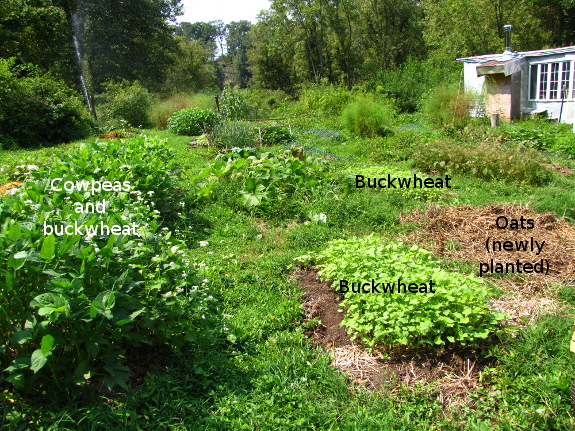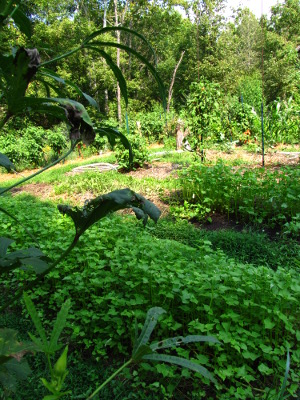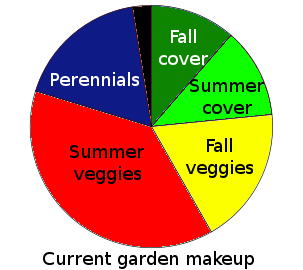
Filling garden gaps with cover crops

 I've been very surprised by
how many cover crops I was able to slip into the garden this year
without adding any extra growing area or putting in fewer table
crops. I never felt like I was leaving beds empty in
previous years (except in the winter), but I often had to save a bed
for a month or two for succession planting of summer crops or for fall
garlic. This year, I filled those gaps with buckwheat
and/or cowpeas and was surprised to realize my plantings ended up
treating a quarter of the garden without specifically setting aside
beds to stay fallow.
I've been very surprised by
how many cover crops I was able to slip into the garden this year
without adding any extra growing area or putting in fewer table
crops. I never felt like I was leaving beds empty in
previous years (except in the winter), but I often had to save a bed
for a month or two for succession planting of summer crops or for fall
garlic. This year, I filled those gaps with buckwheat
and/or cowpeas and was surprised to realize my plantings ended up
treating a quarter of the garden without specifically setting aside
beds to stay fallow.
Meanwhile, I'm already
seeding oats
and oilseed radishes
into beds that I know I won't use again until 2012. Buckwheat is
nice, but the fall cover crops are the real winners, adding much more
organic matter, cutting down on weeds (meaning less work in the
spring), and keeping the garden vibrant during what used to feel like
the downward slide of the garden year. I have to admit,  though, that the best part
about winter cover crops is that there's a relatively narrow window in
which I can plant them --- September 15 is the bitter end for the ones
I've found will reliably winterkill --- so I'm forced to keep the
garden "clean", pulling up that sweet corn and those buggy beans as
soon as they stop producing. An eighth of the garden is now under
winter cover, which means I don't have to touch those beds again until
spring --- how restful is that?
though, that the best part
about winter cover crops is that there's a relatively narrow window in
which I can plant them --- September 15 is the bitter end for the ones
I've found will reliably winterkill --- so I'm forced to keep the
garden "clean", pulling up that sweet corn and those buggy beans as
soon as they stop producing. An eighth of the garden is now under
winter cover, which means I don't have to touch those beds again until
spring --- how restful is that?
I thought you might
enjoy seeing a mathematical snapshot of our garden (minus the woody
perennials). Looks like I have four empty beds --- shame on me!
Want more in-depth information? Browse through our books.
Or explore more posts by date or by subject.
About us: Anna Hess and Mark Hamilton spent over a decade living self-sufficiently in the mountains of Virginia before moving north to start over from scratch in the foothills of Ohio. They've experimented with permaculture, no-till gardening, trailersteading, home-based microbusinesses and much more, writing about their adventures in both blogs and books.
Want to be notified when new comments are posted on this page? Click on the RSS button after you add a comment to subscribe to the comment feed, or simply check the box beside "email replies to me" while writing your comment.

Since our winter cover crops die naturally when really cold weather hits, they're pretty much no work. I'll pull out a huge weed if I see one, but the cover crops tend to outcompete the weeds pretty fast as long as I seed them thick and the weeds aren't perennials. That said, you'd have to do a lot of experimenting to figure out how to kill cover crops down your way --- I suspect none of them will naturally winter kill.
With buckwheat, I pull the plants up as soon as they start to set seeds. The plants are so easy to pull that the process takes perhaps two minutes per bed. So, that should work for you, even if you can't find a winter cover crop that reliably winterkills.
We did fertilize some experimental cover crops this spring, but that wasn't necessary and we won't do it again. No need to prune them.
Shade doesn't seem to be a problem as long as I start the cover crops in the shadiest location a bit earlier to give them time to bulk up before cold hits. Since they don't have to make fruits, they'll still grow in the shade, though perhaps less than in full sun.
Good luck! I hope you do experiment with cover crops and post about it on your blog because I'd be very curious to hear which ones work well in the Deep South.